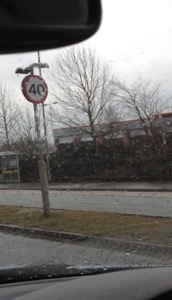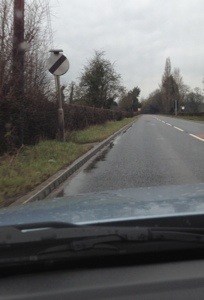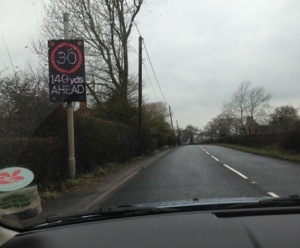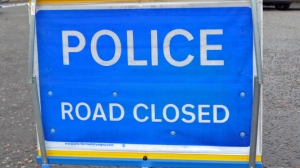The BBC have reported today on an issue arising over a sign error on the M42 motorway. The report cites the CPS in stating that the font used in the sign is incorrect in that it is too tall and too narrow. Lawyers are speaking up saying any prosecutions secured against these signs should be rescinded as the signs are not enforceable. The Highways Agency who is responsible for the placement of the signs are reported to have said they are the right size and clearly visible to motorists. So let’s have a look;
This is a typical overhead gantry used on motorways. These are the signs that are used to enforce the variable speed limits that are starting to be used on the motorway network to ease congestion. This includes temporary use of the hard shoulder as an additional lane. There can be no doubt that they are clearly visible. Here is another example where the national speed limit applies.
So far so good. The variable speed limit sections on motorways are often covered by cameras that can determine your average speed between specific points. The process is automated and the math is simple.
Speed set; Car checked at time at point 1. Car checked at time at point 2. (distance between point 1 & 2 is known). Speed = distance / time.
The cameras catch an image of your car at point one and two. It then calculates the speed and if over the limit that has been set the paperwork for a provisional offer of a fixed penalty notice will be despatched to the registered keeper along with a 172 query ( in simple terms.. if you weren’t the driver you must tell us who was).
I’m not going to go into the long and contentious debate about speed cameras, their impact on road safety and whether they are a cash cow. I have a very simple view. If you drive at the speed limit there could be a camera on every corner and it wouldn’t make a jot of difference. If you don’t drive at the speed limit then you must be prepared to face the consequences which can be a fine and points to a prosecution for death by dangerous driving. The choice as they say, ‘Is yours’.
The next question then has to be are the signs the correct sizes? The first thing to consider is the speed limit signs we all know and love. Lets have a look at some; (and for this I thank my eldest daughter who snapped a few this afternoon as we drove around.)
As can be seen they show a variety of speeds. They can also be different sizes and have different backgrounds but visually the enforceable sign parts are the same. Furthermore, no matter how big or small they are, they must maintain the aspect ratio given in the relevant regulations. Pretty much everything on our roads has to comply with size/dimension/colour rules. Centre lines, double yellow lines, pelican crossing zig zags all have to meet the requirements and must be applied by local authorities across the country. This way there is never any doubt or confusion about what the signs or markings mean no matter where you are.
This is reinforced when we look at the Highway Code where as trainee drivers we learn the road signs. The Highway Code gives illustrations of what the signs must look like. The signs here are giving orders and are therefore ‘prohibitive’. They are not warning or cautions signs. They MUST be complied with.
There are some different signs though. Take a look at this one below;
This one is very similar to those on the overhead gantry on the motorway but it is not saying 30mph NOW. It is warning drivers that a 30mph speed limit is ahead. This stretch of road is actually governed by the national speed limit and driving past this sign in a normal car at 60mph will not constitute an offence. However, if you maintain that speed when you pass the proper signs in 140yds then you most certainly will.
It is clear that the 30mph advance warning sign above is identical in colours to those shown on the motorway gantry. It has a red border, a black background and white numerals. However, when we look at the Highway Code and all the other speed signs above they are different. The official signs are red borders, white backgrounds and black numerals. They are in fact nothing like each other at all.
Now whilst the 30mph sign is a warning and not enforceable, the signs on the motorway have been treated as prohibitive and many prosecutions have arisen when motorists have exceeded the limits displayed. In the BBC article they indicate that the CPS have identified a problem with the size and shape of the numerals. Looking at them there clearly is a problem with the size and shape of them but there is also a HUGE problem in that the colours used DO NOT comply with the Highway Code. Furthermore, they do not comply with the Traffic Signs Regulations and General Directions 2002.. Schedule 2 of these regulations shows images and dimensions for the relevant signs. The speeding signs can be found at images 670 and 671. You can also see that there are permitted variants for 670 (standard speed signs) at Schedule 16, item 1. There are no permitted variants of 671. If you understand what Schedule 16 item 1 means I’d be pleased to know but in a nutshell there can be some minor changes to numerals. However, what is clearly apparent is the legislation does not say that colours of backgrounds and or numerals can be interfered with.
With the above in mind the warning sign image above is still not causing any problems. The motorway ones on the other hand look questionable.
There must be a reason for this. There must be some regulations that have since been added. The regulations enacted that allowed the variable speed limits and temporary use of the hard shoulder to be lawful must give an exception. So we need to look at those regulations which for the M6 in the West Midlands can be found in The M6 Motorway (Junctions 8 -10A)(Actively Managed Hard Shoulder and Variable Speed Limits) Regulations 2010.
Section 4 of these regulations covers the variable speed limits. It details clearly what a ‘speed limit sign’ is and when one is actually passed. In Section 4(5)(b) it says;
“speed limit sign”, in relation to a vehicle, means a traffic sign of the type shown in diagram 670 in Schedule 2 to the 2002 Regulations”
In effect we therefore do not have a special exemption. The relevant regulations for the variable speed limits point us straight back to image 670 in the 2002 sign regulations and we know from those regulations that the sign must be; round, red border, white background, black numerals. Oh dear. It would seem that the ‘speed limit signs’ on the motorway do not conform with regulations. It is also quite obvious that image 671 allows for no variants whatsoever. So looking at the motorway gantry example image above (black background with white diagonal bar) is the complete negative of what it should be (white background with black diagonal bar).
So what does this mean? In order to be enforceable, road traffic signs must comply with the regulations. The motorway variable speed signs do not comply with the regulations and are therefore not enforceable. This means you cannot be prosecuted. If you have then you have fell foul of the law and perhaps you should speak to a solicitor.*
*see supplement
As an alternative example think of the Stop/Go signs that are used by road workers manually controlling traffic. The GO sign is a green circle with white letters. The STOP sign used to be a red circle with white letters. Yet the STOP and GIVE WAY sign was always an octagon. A few years ago this became an issue and now in the Highway Code we can see that the STOP sign can still be round but it has to have the octagon shape showing. When it was first changed some local authorities had a metal frame that fitted around the circular sign to make it octagonal in shape. A change that was brought about to make the manually operated STOP sign to mirror the STOP and GIVE WAY sign.
In the motorway speed signs scenario the fact remains that the CPS have raised concerns about the size and shape and numerals but as far as I can tell have not given any consideration to the fact the signs colours are incorrect.
You should know that as a disclaimer to my above thoughts;
There may be legislation I’ve missed that covers the motorway signs.
I cannot guarantee success in any action you may choose to take to overturn a prosecution.
Whilst some people may be rejoicing having read the above and are even now pulling out their driving licence others will be jumping up and down. The signs are obvious. Even if the colours are the wrong way around their meaning is obvious and anyone who ignores them and speeds is a fool. I’d agree. They are obvious and having dealt with the aftermath and death after the abuse of speed limits I fully endorse it. Speed KILLS. End of.
Yet we have to play by the rules. If the rules allow for sign variants in this case then all is well. If the rules don’t allow for variants then they are not enforceable. We cannot prosecute someone for theft if their actions don’t fit the mens rea and actus reus. We can’t simply skip past these requirements and this is why officers are often frustrated when they ‘know’ someone has committed a crime but have insufficient evidence to prove it. We have to play by rules. The same applies to road signs.
The gantries and signs will have been placed by the Highways Agency. You’d expect them to know better wouldn’t you? Well if I’ve missed some obscure legislation then maybe they did. As it stands, at least from my perspective, they got it wrong. I wonder if expensive signs were ordered, built, transported and installed and when they were switched on somebody nudged the Chief Exec and said “Er. Sir. They are all the wrong colours”. At that point an expensive option to replace all the signs could have been considered. Another solution would have been to petition an amendment to the regulations to make them lawful. It seems at the moment they did neither.
If I turn out to be correct, I wonder whether an amendment to the legislation is brought about that is retrospectively laid out to cover the signs from the date of installation? Cynical? Moi?
Supplement
Thanks to @marks359 I have now bee pointed to section 58 in article 6 of the 2002 regs that covers white, off white or yellow letters, symbols or numerals on a dark background. If we are both reading this correctly then this covers the area of my argument. There still remains the issue as raised by the CPS with regard to size and shape.
Furthermore, I would still question why the M6 regs don’t say “a sign as shown at 670 schedule 2 unless as required under reg 58”.
I also have concerns about how one sign is enforceable and an identical sign as on the rural road image above is not. The idea of road signs is that they are totally unambiguous. I find it hard to believe with technology these days that a sign that is electronic cannot be manufactured to show a speed sign as portrayed by 670 without changing the regulations to make it fit.
It is clear the area is a total minefield and ridiculously over complicated. What would the Plain English campaign think? I look forward to seeing how the CPS issue plays out.










